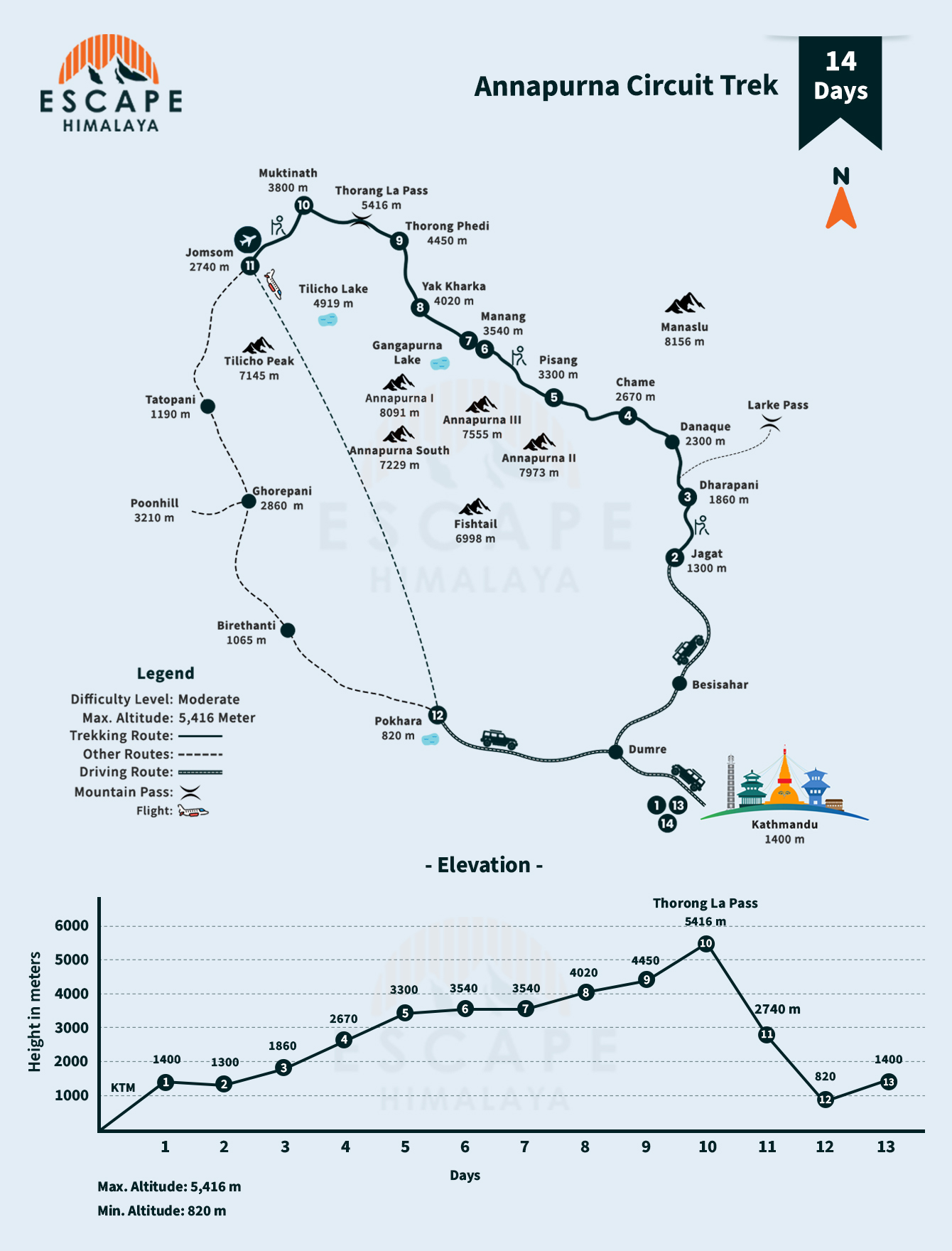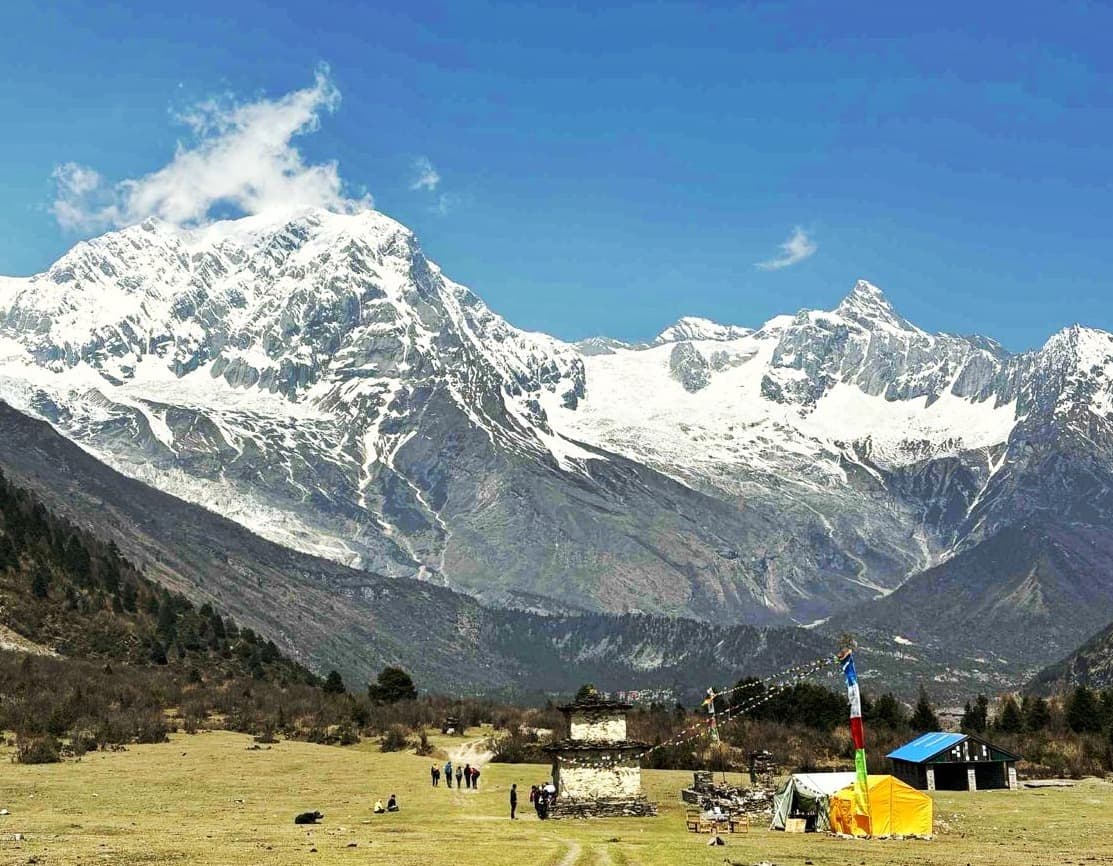The Annapurna Circuit Trek (ACT) is one of Nepal’s most famous and different trekking routes. Extending between 160 to 230 kilometers, depending on the beginning and finishing focuses, this circular path offers a sensational journey in landscapes—from subtropical timberlands and terraced farmlands to tall elevated landscapes and semi-arid deserts. A point-by-point route outline of the Annapurna Circuit trek usually starts in Besisahar and closes in Jomsom or Nayapul.
The path rises through charming towns like Chame, Pisang, and Manang, with acclimatization days carefully arranged to offer assistance to trekkers to higher heights. The most tiring, still satisfying part of the trip is crossing the Thorong La Pass at 5,416 meters, the highest point on the way. From there, the route slips into the Bronco region, passing through Muktinath, a consecrated pilgrimage site for both Hindus and Buddhists.
Side trails such as Tilicho Lake or makeshift routes to Nar Phu Valley can be included to customize the route. Most trekkers take a counterclockwise route to continuously acclimatize, and some time recently attempt the tall pass. Route maps also incorporate major points of interest, rise profiles, evaluated distances, and convenience stops to make planning smoother.
Whether you're utilizing a printed outline or a computerized GPS device, a route outline is a fundamental part of planning for the Annapurna Circuit. It gives clarity, makes a difference in pacing your days, and guarantees that you stay on track all through this awe-inspiring trek.
Annapurna Circuit Trek Map

Annapurna Circuit Itinerary
- Day 01: Arrive at Tribhuwan International Airport, Kathmandu
- Day 02: Drive from Kathmandu to Jagat (1,100m) Distance: 186 km | Duration: 8 Hours
- Day 03: Jagat to Dharapani (1,960m) Distance:12-14 km | Duration: 6 Hours
- Day 04: Dharapani to Chame (2,630m) Distance:15-16 km | Duration: 5 Hours
- Day 05: Chame to Pisang (3,300m/10,825ft) Distance: 14-15 km | Duration: 6 Hours
- Day 06: Pisang to Manang (3,370m/11,710ft) Distance: 16 km | Duration: 7 Hours
- Day 07: Manang - Acclimatization Day, Distance: 16 km Duration: 2-3 Hours
- Day 08: Manang to Yak Kharka (4,110m/13,480ft), Distance: 11 km | Duration: 4 Hours
- Day 09: Yak Kharka to Thorong Phedi (4,600m), Distance: 8 km | Duration: 4 Hours
- Day 10: Thorong Phedi to Muktinath (3,800m) crossing over Thorong La Pass (5,416m), Distance: 16.5 km | Duration: 7-8 Hours
- Day 11: Muktinath to Jomsom (2,600m) Distance: 16.5 km | Duration: 5 Hours
- Day 12: Jomsom to Pokhara Flight, Duration: 20 Minutes
- Day 13: Drive Back to Kathmandu, Duration: 6-7 Hours
- Day 14: Farewell/End of the Annapurna Circuit Trekking
Why Choose ACT Trek: Trek with a Licensed Professional Guide
Choosing the Annapurna Circuit Trek (ACT) implies submerging yourself in one of the world’s most exciting trekking enterprises. But what lifts this involvement is undertaking it with a proficient, government-licensed guide. An authorized guide brings security, ability, and local knowledge to your travel. The ACT path traverses high-altitude terrain and remote regions, where the climate can be extreme and health issues like altitude sickness are a genuine risk. A proficient guide is prepared to begin with help and high-altitude security, making a difference if you oversee these challenges with confidence.
Too, orderlies are well-clued in the culture, conventions, and geography of the Annapurna region. They enhance your experience by clarifying local traditions, suggesting off-the-beaten-path spots, and making a difference when you interact with the communities you pass through. Additionally, an authorized guide guarantees smoother logistics—from orchestrating settlement and licenses to overseeing transportation and supplies. Their nearness permits you to center on the magnificence of the Himalayas without stressing approximately trip details.
In short, trekking with a proficient guide on the Annapurna Circuit to Tilicho Lake changes your experience from a physical challenge into a secure, enriching, and exceptional social experience.
Why Choose a Local Company for a Nepal Trek
Hiring a nearby company for your Nepal trek is one of the most astute and most dependable choices you can make. Not as does it improve your encounter, but it also bolsters the neighborhood economy, culture, and sustainability practices.
Local trekking offices have a hint of understanding of the region, trails, and climate conditions. They keep up near ties with nearby communities, teahouse proprietors, and back-of-house staff. This permits them to give more personalized benefits and superior calculated routes of action compared to universal administrators. You’re not a fair client—you’re an invited visitor in their homeland.
Local companies also utilize certified guides, watchmen, and bolster staff who are well-versed in the area’s geology, culture, and crisis management. These experts guarantee your security while improving your trek with stories, dialect, and social insight.
By booking with a local administrator, you’re directly contributing to Nepal’s economy and supporting sustainable tourism. Cash remains inside the community, enabling local people and empowering preservation. It also discourages misuse and makes a difference by implementing reasonable compensation and working conditions for doormen and guides.
Furthermore, nearby companies are better prepared to offer adaptability in your schedule, adjust to climate or wellbeing conditions, and give quick feedback if issues emerge during the trek. They can effortlessly improve lodging, transportation, or licenses on short notice.
In a rundown, choosing a nearby company for your Annapurna Circuit trek is a win-win—it improves your travel and benefits the broader Himalayan community in enduring ways.
What Permits Do You Need for the Annapurna Circuit Trek?
To trek the Annapurna Circuit, two fundamental grants are required:
TIMS (Trekkers' Data Administration Framework) Card
This guarantees your trek is enrolled with the specialists, improving security and allowing for crisis help if required. The toll taken for autonomous trekkers is marginally higher than if orchestrated through a neighborhood agency.
Annapurna Conservation Area Project (ACAP) Permit
The Annapurna Circuit passes through the Annapurna Conservation Zone, so this permit is required. The reserves go towards protecting the natural environment and supporting neighborhood communities within the region.
Both licenses can be obtained in Kathmandu or Pokhara through the Nepal Tourism Board or by means of an enrolled trekking organization. Be beyond any doubt to carry different photocopies of your international ID and later passport-sized photographs when applying. Continuously keep your grants with you during the trek, as they are regularly checked at checkpoints along the route.
Best Time for Annapurna Circuit Trek
The Annapurna Circuit is best satisfied in the spring( March to May) and edit fall ( late September to December) seasons. These months offer the most consistent climate, clear skies, and disorienting mountain sees. Spring brings rhododendron sprouts, charming temperatures, and longer sunshine hours. It's an incredible time to appreciate the dynamic scene and watch natural life in the lower valleys.
Autumn, on the other hand, is the post-monsoon season. It boasts fresh discontent, negligible precipitation, and excellent visibility of the snow-capped Annapurna and Dhaulagiri ranges. The climate is cool and dry, perfect for crossing the high-altitude Thorong La Pass safely.
The downtime months( December to February) are critical, colder, and always incorporate snow at progressively higher elevations, making the Thorong La Pass challenging or perilous to cross. Storm season (June to December) brings overwhelming rain, avalanches, and leeches, particularly in the lower regions, and is by and large not recommended for ACT.
Choosing the right season guarantees a more secure, more agreeable, and outwardly marvelous trek.
The flight from Jomsom to Pokhara is one of Nepal's most scenic and short domestic air routes. It covers a distance of approximately 67 kilometers and takes around 20 to 25 minutes. The route provides breathtaking aerial views of the Annapurna and Dhaulagiri mountain ranges, Kali Gandaki gorge, and surrounding hills. Due to the challenging terrain and changing weather, flights operate only during early morning hours.
Flight Options
Airlines and Schedules
Several local airlines operate daily flights on this route, including Tara Air, Yeti Airlines (via subsidiary), and Summit Air. Flights typically depart between 6:00 AM and 10:00 AM, with the earliest flights having the highest chance of operating on time. Afternoon flights are rare and discouraged due to strong mountain winds. During peak trekking seasons, flights are more frequent, but also book up quickly.
The flight from Jomsom to Pokhara is one of Nepal's most scenic and short domestic air routes. It covers a distance of approximately 67 kilometers and takes around 18 to 25 minutes. The route provides breathtaking aerial views of the Annapurna and Dhaulagiri mountain ranges, Kali Gandaki gorge, and surrounding hills. Due to the challenging terrain and changing weather, flights operate only during early morning hours.
Jeep Transportation
Traveling from Jomsom to Pokhara by jeep is a scenic and reliable alternative to flights, particularly when weather conditions disrupt air travel. The journey takes about 6 to 7 hours, passing through rugged mountain terrain via Beni. especially during the monsoon, the drive rewards passengers with spectacular views of the Kali Gandaki Valley and the charming mountain villages along the route
Conclusion:
The Annapurna Circuit trek is more advanced than a reasonable walk through the Himalayas; it's a transformative encounter that combines common respectability, social immersion, and personal triumph. From the wealthy green hills of the lower valleys to the snow-covered peaks at Thorong La, the travel offers breathtakingly different qualities in view, natural life, and human connection. Trekking with an authorized guide guarantees your security, upgrades social understanding, and adds profundity to the whole experience. Choosing a nearby trekking company amplifies those benefits, making a more bona fide and moral travel while supporting the communities that make this trek possible.
In conclusion, the Annapurna Circuit is not a physical circle around a mountain; it’s a personal circle of improvement, education, and affiliation. Whether you are a set pioneer or a to begin with-time mountain dweller, this trip ensures recognition that will final a lifetime. When done right with heading, reason, and regard, it’s a venture that truly epitomizes the soul of the Himalayas.






